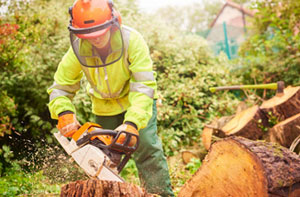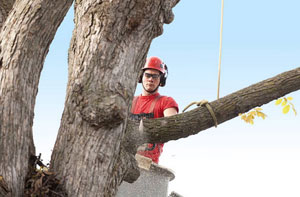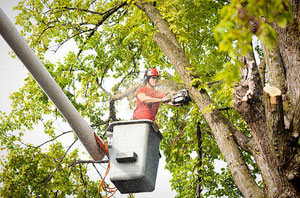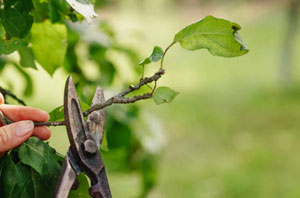Willingdon Tree Surgeon East Sussex: Trees are an important feature of many gardens and properties in Willingdon, and they will often transform an otherwise two dimensional landscape by adding structure, style and substance. But issues can occur when trees are neglected or are damaged by extreme weather conditions, for instance high winds or flooding. The best option if you have work that needs undertaking on your trees, is to speak to a qualified tree surgeon in Willingdon.
Hiring a non-qualified operative for tree work or attempting to do it yourself, could cause damage to property, harm your trees, or even be life threatening. However, tree work is certainly not a safe undertaking, even for qualified tree surgeons, who are aware of all the risks. Within the industry there are an average of 140 severe injuries and 3 deaths each year, making tree surgery one of the most dangerous jobs in the UK.

There is also a risk to life from damaged or poorly maintained trees in Willingdon, since around 5 people per year are fatally wounded in the UK by falling trees and branches. If you employ somebody to conduct tree work and subsequently property is damaged, or an injury occurs, you may be liable to third-party compensation claims. The above are merely some of the reasons why it is important to employ a professional tree surgeon to carry out the work on your trees. (All figures are from HSE).
CHOOSING A TREE SURGEON IN WILLINGDON - A certified Willingdon tree surgeon should be a registered member of one or both of the two industry bodies found in Britain. You can check out the professional standing and membership of any tree surgeon on the websites of either the Arboricultural Association (AA) or the International Society of Arboriculture (ISA). To discover whether any specific local tree surgeon has ARB Approved Contractor status and has membership of either of these associations, you can check out this website.
For mediation and for help and guidance at any stage during or after the work has been completed, you are able to contact either one of these industry associations.

If someone offers to provide you with a quote for any tree work and you're unable to find them on this directory, you should courteously decline their offer of work and find an approved tree surgeon. When you are reassured of their professional memberships and accreditations you should try to get at least three different price quotes from various companies in Willingdon. You should ask the questions below whilst acquiring the quotes, stating you need them to provide the answers because of the risks of the work involved:
- Would it be possible for me to contact a person you have recently done work for, so that I can inspect your tree work? It is recommended that you perform an independent check of any recent work.
- Exactly what level of insurance coverage have you got? Don't entertain a tree surgeon in Willingdon with any less than five million pounds public liability insurance as recommended by the AA and ISA.
- Do you give written quotations? Only ever accept a written quote. NEVER accept a verbal quote alone.
- Do you have documentary verification of your qualifications, professional membership and a NPTC certificate for the use of a chainsaw? Any tree worker who uses a chainsaw, must by law hold a NPTC/LANTRA certificate. A trained Willingdon tree surgeon could hold Certificates and National Diplomas in Arboriculture.
On the written quote that you receive, you'll need there to be clear and precise specifics of all the tree work that's being undertaken. It should state whose responsibility it is to remove tree branches, stumps and waste, and should also include specifics of any trees which may be protected, and the steps required to get permission to work on them. You should also make certain VAT is included on the quote. It's important to recognise that you have a responsibility to hire only capable tradespeople to work on your property and trees. This is outlined by the "Common law duty of care responsibilities under the Occupier's Liability Acts of 1957 and 1984."
PRIOR TO WORK COMMENCING - Your chosen Willingdon tree surgeon should enquire whether any of your trees are protected and take the necessary steps to make certain that any work can get the go-ahead from the local authorities. Finding that a tree has protected status does not mean that work cannot be carried out, as even protected trees need maintenance so as to cut back dead or damaged wood and ensure the safety of the public.
If your property in Willingdon is located within a designated conservation area, the Local Planning Authority will need at least 6 weeks written notice of any intended tree work. This only applies to trees with a stem diameter of over 7.5 centimetres in diameter, at a point 1.5 metres from ground level. Also, if the branches of a protected tree need to be thinned or pruned in order to encourage and sustain growth, written notice won't be necessary.

After conducting a complete assessment of your trees health, your chosen Willingdon tree surgeon will determine the required remedial treatment and how best to achieve the required outcome in a safe manner. This involves doing a full risk assessment to include public areas, your property and any section of neighbouring properties that could be affected by falling debris and branches. This stage will also ascertain the level of protection needed and the number of workers required. This will include a number of safety measures together with personal protection equipment to guarantee the safety of the general public and nearby property.
ON THE DAY OF WORK - To keep unauthorised persons and passers-by away from the work area, cones, safety measures and barriers will be put in place before any tree felling, climbing or cutting of branches begins. Where there is the possibility of branches and debris falling onto a highway, it may be necessary to briefly halt the traffic.
Varying levels of protection will be needed by the tree surgeon subject to what work needs to be undertaken. When doing basic work with a chainsaw, to avoid serious cutting injuries to the hands, torso and legs, they will as a bare minimum be wearing protective clothing. Every worker involved in the operation, must at all times be wearing eye and head protection, and high-vis clothing.
Additional operatives will usually be necessary to help with the removal of high branches and sections of tree trunk, especially if working at height is involved, and where ladders and associated climbing equipment is being used. It's advisable to inform your next door neighbours of the need for unhindered access, as a skip or other method of transporting the waste away will be stationed as close as possible to the work area.
AFTER COMPLETION OF WORK - The whole area can be cleared of all debris, and all the branches and waste can be transported away, as soon as all tree work has been finished. Especially in the case of any protected trees, a certificate of work will then be created by your tree surgeon, which will be signed off and a copy handed to you. If there were any public spaces that required safety measures, this protection will be taken away and footpaths and roads will be re-opened to the public.
Issues or problems should be fixed straight away by approaching your tree surgeon directly. If any further arbitration is needed, and your tree surgeon is an approved member of a professional trade association, you can get guidance and help from the Arboricultural Association or the International Society of Arboriculture so as to arrive at an acceptable conclusion.
Locally based Willingdon tree surgeons will likely have the telephone dialling code 01323 and the postcode BN20. They'll operate in Willingdon itself, along with nearby areas such as Summerhill, Hellingly, Wannock, Foulride Green, Selmeston, Sayerland, Magham Down, Upper Dicker, Stone Cross, Litlington, Polegate, Hankham, Arlington, Hailsham, Eastbourne, Jevington, Alfriston, and these postcodes: BN20 9LN, BN22 0RP, BN20 9HX, BN22 0NL, BN20 9LB, BN20 9ST, BN20 9HY, BN22 0JJ, BN22 0HS, BN22 0JS.
If you need this sort of service it's unquestionably advisable to hire a competent tree surgeon. Willingdon business and home owners can benefit greatly from the expertise that are the trademark of a seasoned professional.
Tree Emergencies Willingdon
Although emergencies are infrequent with regards to trees in your garden, accidents can happen, therefore it may pay you to have an emergency telephone number for a tree surgeon in Willingdon. Some Willingdon tree surgeons offer a 24 hour service, and when there are storms and high winds, they typically face a spike in emergency call outs. The likelihood of injury or damage is increased when the weather is stormy, with branches snapping off and plummeting to the ground below, and sometimes even whole trees toppling over. Plummeting tree limbs and branches can cause busted garden furniture, damaged fences, smashed greenhouses and squashed sheds, therefore rather than having to cope with the consequences of such occurrences, prevention is the key.
When sizeable tree branches snap of and drop onto public pavements, streets and railway tracks, the local authorities in Willingdon will also frequently need emergency tree care services.
When a tree has lost some branches it could become uneven or lopsided, with more branches and weight on one side. This can be both aesthetically displeasing and hazardous, so the tree might need to undergo a "re-balancing" procedure. A local Willingdon tree surgeon who offers 24 hour emergency services must be contacted to deal with all these problems, and you shouldn't try to sort them out yourself.
Control of Vegetation

It is not simply the care and removal of trees that your nearby Willingdon tree surgeon will be able to assist you with, but also any kind of rampant vegetation that's jungling up your property. Professional tree surgeons will normally be delighted to get rid of weeds, shrubs, overgrown vegetation and bushes which may be thriving near buildings, patios, sheds, paths or driveways, and generally causing a hassle. If you are going to maintain your garden effectively then all this excessive growth must be eradicated frequently, and if you have the time and inclination then this is definitely a job you can accomplish yourself if you're fit and able enough, or you might ask your local tree surgeon to call now and again to keep it in check. The management of vegetation is important if you are going to maintain easy and safe entry to every section of your property and if this is overlooked the vegetation and plants will very quickly get out of control and lessen the enjoyment of your garden. Apart from anything else your garden will also look a lot better when maintained properly.
Air-Spading Willingdon
When you have concerns about a tree's health, this might be down to any number of factors, but is very often because of problems with the root system. A local tree surgeon in Willingdon might need to access the roots to check for soil compaction, root rot, or other related problems.
During the past this was fairly tricky, due to the potential for damaging the roots in the process of digging down. The system that many modern day tree surgeons use is known as "air spading", whereby compressed air is employed to break down and clear away compacted soil without damaging tree roots or underground utilities.
On occasion, building work, passing vehicles or foot traffic can cause the soil surrounding a tree's roots to become compacted, and this is known to adversely affect its health. When a tree becomes "stressed" it's more prone to attack by disease, pests and insects, and this stress can be caused by a lack of water and nutrients. Root flare issues can also be resolved with air-spading, and this is where the flare at the base of the tree gets covered with too much soil, increasing the chances of root rot by causing the tissue to break down.
This clever process involves the use of an air-spade tool and an air compressor which blows air directly into the soil at a speed of twelve hundred miles per hour, the air enters the spaces in the soil and instantly breaks it apart, while leaving tree roots and nearby utility lines untouched. All of the soil is forced away from the roots by the highly powerful flow of air, meaning that the investigation can take place immediately. A solution can then be implemented for any issues, and the soil replaced with a looser layer of wood chips and fertiliser to help revitalize the tree.
Tree Transplanting Willingdon

Re-planting fully-grown trees is an intricate, but relatively simple process nowadays, mainly due to advanced vehicle mounted spades, tree lifting devices and other specialised tools. Fully developed trees can be transplanted onto new properties to achieve an instant landscaping appearance, or out-of-control woody areas could be thinned without having to stoop to tree felling.
Moving trees in Willingdon can be completed any time of the year, but during the warmer months the soaking of the ground becomes especially vital so as to cause the minimum amount of stress on the tree's root-ball. To lift a tree from the earth a tractor mounted mechanical tree spade is pushed down into the dirt to encompass the main root ball, before hauling the whole tree free. The tree can then be replanted or temporarily stored before its re-planting in a new location.
Even protected trees can be lifted and transplanted by a competent tree moving firm in Willingdon, providing that all appropriate preservation orders and authorisations are approved by the authorities and woodland organisations. (Tags: Tree Transplanting Willingdon, Tree Replanting Willingdon, Tree Moving Willingdon).
Dutch Elm Disease
No longer the problem that it once was, Dutch Elm Disease (Ophiostoma novo-ulmi) has wiped out many millions of precious elm trees all around the UK over the last five decades or so. Inadvertently introduced into the United Kingdom, in infected elm logs imported from Canada in the late 1960's, Dutch Elm Disease is caused by the fungus Ophiostoma novo-ulmi which is spread by the elm bark beetle (especially the Scolytus genus).
Its swift spread was primarily down to to elm products such as saplings, crates, bark mulch, and logs with the bark on, being transported around the British Isles. This horrible disease didn't only impact elms in the UK, but also devastated tree stocks in mainland Europe, North America and New Zealand. Whilst the origins of DED are as yet unproven, the suspicions are that it first came from Asia (probably Japan).
Typically first showing up in early summer, the main signs of DED disease are:
- New shoots dying back from the tips.
- Twigs turning into a "shepherd's crook".
- Foliage that turns yellow, shrivels and dies.
- Dark streaks underneath the bark of twigs.
As there are now hardly any sizeable elms in the British countryside, the elm bark beetle's habitat has been pretty much decimated, the result of which has been a slowing down of DED. The propagation of young saplings which are so far resistant to DED is a continuing project.
You can speak to your neighbourhood tree surgeon for advice and guidance, if you are suspicious that you may have affected elm trees on your property in Willingdon, or you can request a diagnosis from the Tree Health Diagnostic and Advisory Service (THDAS), for which you will be charged a fee.
(Tags: Dutch Elm Disease Willingdon, Dutch Elm Disease Signs, Spotting Dutch Elm Disease).Storm Damaged Trees Willingdon
Of all the living things in our gardens, trees seem to be the strongest, sturdiest and the most likely to withstand the vagaries of Mother Nature. Actually certain types of tree can live and continue to grow for several hundred years.
However, when confronted by certain conditions they can be very vulnerable to the elements, and it isn't just falling branches or limbs that can result, but the entire tree can fall over in extreme weather. The main weather related issue for trees is wind, and as the number of violent storms and weather events in Willingdon escalates due to climate change, this kind of damage has become more commonplace. Heavy snow during winter can also cause problems, as can saturated soil resulting from floods or extended periods of rainfall.
To lessen the chance of problems with your trees in times of severe weather, it's advisable to get a local Willingdon tree surgeon to check them out once in a while, and prune any dead, dying or overhanging branches.
Lightning rods, copper conductors, or other lightning protection systems are also important for bigger trees, to lessen the chances of them being struck by lightning and to safeguard nearby buildings and property which may be vulnerable to side-flashes ("jumps") that result in more damage, along with harm done to the tree itself. A tree that's struck by lightning can be severely weakened or even killed, a weakened tree can be left vulnerable to disease, pests or decay. You may not believe that lightning strikes are all that common, yet in the UK alone there are about three hundred thousand strikes recorded each year.
To safeguard your trees from being damaged by storms and lower the chances of drastic consequences should an unstable tree crash down as a result of extreme weather, ask your local Willingdon tree care specialist what can be done. (Tags: Storm Damage Prevention Willingdon, Storm Damaged Trees Willingdon, Storm Damage Willingdon).
Firewood/Logs Willingdon

If you're in the market for logs or firewood in Willingdon, tree surgeons are usually a great source for this commodity. This is no great surprise, as tree surgeons spend most of their life cutting down branches and trees.
Recently felled logs and branches are frequently available "free to collector" from certain Willingdon tree surgeons, who are simply glad to get shot of them. Other local tree surgeons, with the room to store them, will dry and season the logs and sell them by the bag or tonne, and will sometimes deliver them to your home.
Logs having a moisture level of below 20% are best for burning on your log burner or open fire, and these will have been dried out for twelve months or more. Normally tree surgeons in Willingdon will have supplies of hardwood logs, and the good thing about these is that they give a sustained burn, and provide many hours of heat. If you can get a small supply of softwood logs, these are terrific for starting a fire, and upon which you can bung your seasoned hardwood logs once the fire is roaring.
Deadwooding Willingdon
All experienced Willingdon tree surgeons will undertake the process of dead-wooding (or deadwooding), which is a necessary element of tree care and management. Dead-wooding involves the careful removal of dead and dying branches that may pose a threat to pedestrians, vehicles or homes. Tree branches can die for a variety of reasons, with a lack of light, damaged roots, disease or attack by pests, recognised as the most commonplace.
Whilst safety is of course the most frequent reason for dead-wooding a tree, it's sometimes necessary to make the tree more visually appealing, or so that the tree itself will benefit from the process. A tree that has too many dying, dead and damaged branches is prone to infestation by insects and disease, therefore you can radically improve the health of a tree by removing these compromised branches. Trees that have lots of dead wood also look ugly, so to improve its appearance, this should all be removed.
Only larger and more substantial dead branches will usually be cut off, because in most instances the smaller ones will not pose any great risk. Nevertheless, any dead branches that are in excess of fifty millimetres in diameter might need to be removed in places where a tree hangs over a garden, a public space, a home, a road or a park in Willingdon. (Tags: Deadwooding Willingdon, Dead-Wooding Services Willingdon, Dead-Wooding Willingdon, Dead-Wooding Trees Willingdon).
Tree Removal Willingdon

If your tree presents a threat to safety, you've got a dead/dying tree, the tree is infected, the tree is hampering a new construction, the tree roots are damaging retaining walls/foundations, your tree has been damaged by windy weather or your tree has grown too large, then you could have a bona fide basis for felling and removing a tree. Otherwise tree removal should be the last resort, given that trees are by and large an attractive and beneficial addition to your garden. Numerous people in Willingdon plan to take out a tree or trees to gain a better view or even to stop the nuisance of fallen leaves, this is not imperative and ought to only be done if the issue is serious. (Tags: Removing Trees Willingdon, Tree Felling Willingdon, Tree Removal Willingdon)
Crown Thinning Willingdon

The elimination of a lot of the smallest branches towards the tree's outer crown to deliver a foliage density that is consistent all the way through and does not change the shape or size of the tree, is called crown thinning. This kind of procedure is usually only performed on trees with broad leaves and is done to lower the stress put on certain limbs caused by snow, ice, wind, or gravity, to decrease the total weight of the crown of the tree, to let more sunlight in, to prevent the tree from being uprooted in strong winds or to reduce the tree's wind resistance. The all round size and structure of the tree ought not to be transformed by crown thinning, and should just bring about a uniform foliage density encompassing uniformly distributed branches.
Tree Surgery Tasks Willingdon

Willingdon tree surgeons will likely help you with tree waste removal in Willingdon, tree reshaping, tree work, tree fertilising, waste removal, crown removal in Willingdon, tree pruning, crown thinning, pest control in Willingdon, stump treatment, tree lightening protection in Willingdon, coppicing, staking, retrenchment pruning Willingdon, safety inspections, tree pollarding, felling of storm damaged trees, shielding trees from grazing, airspading in Willingdon, shrub maintenance, vegetation management in Willingdon, woodchipping, dead-wooding in Willingdon, hedge reduction in Willingdon, emergency tree surgery in Willingdon, tree planning, tree reduction in Willingdon, drop crotching Willingdon, root flare exposure, stump grinding and other tree surgeon services in Willingdon, East Sussex. These are just a handful of the tasks that are undertaken by a tree surgeon. Willingdon companies will tell you about their full range of services.
Tree Surgeons Nearby
Also find: Hankham tree surgeon, Foulride Green tree surgeon, Litlington tree surgeon, Upper Dicker tree surgeon, Summerhill tree surgeon, Wannock tree surgeon, Stone Cross tree surgeon, Arlington tree surgeon, Alfriston tree surgeon, Sayerland tree surgeon, Magham Down tree surgeon, Hellingly tree surgeon, Selmeston tree surgeon, Jevington tree surgeon and more. Almost all of these places are covered by tree care companies. Home and property owners in these localities can get price quotes for tree surgery by clicking here.
Tree Care Services Willingdon
- Willingdon Eco-Plugging
- Willingdon Tree Pollarding
- Willingdon Tree Management
- Willingdon Tree Reduction
- Willingdon Crown Reduction
- Willingdon Tree Felling
- Willingdon Tree Reshaping
- Willingdon Site Clearance
- Willingdon Root Decompaction
- Willingdon Crown Lifting
- Willingdon Forestry Management
- Willingdon Tree Maintenance
- Willingdon Dead Wooding
- Willingdon Crown Cleaning
 Tree Surgeon Willingdon
Tree Surgeon Willingdon Tree Care Willingdon
Tree Care Willingdon Tree Surgery Willingdon
Tree Surgery WillingdonTo read local Willingdon info check here
Tree Surgery BN20 area, and dialling code 01323.
Tree Surgery Willingdon - Tree Surgeon Willingdon - Stump Grinding Willingdon - Tree Care Willingdon - Tree Felling Willingdon - Crown Thinning Willingdon - Forest Management Willingdon - Tree Surgeons Willingdon - Vegetation Management Willingdon






